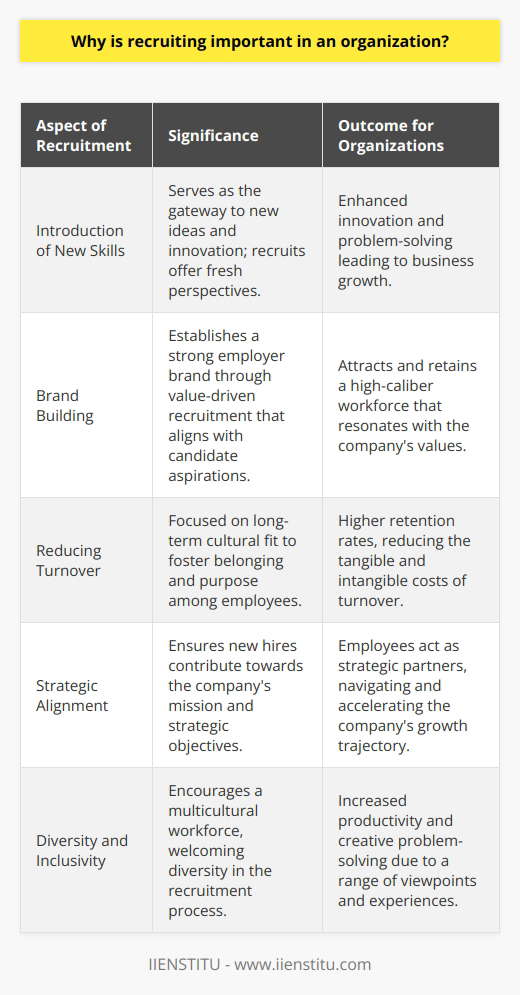
Benefits of Win-Win Hiring include ensuring the right fit for both parties and allowing the candidate to better understand the job and the company before committing. The process should involve a thorough evaluation of the candidate’s skills and abilities and their fit factors. The candidate should be provided with the necessary information to make an informed decision.
Introduction
Benefits of Win-Win Hiring
Defining the DOING and BECOMING
In-Depth Assessment Process
Providing Candidates with Information
Win-Win Hiring: Hiring for the Anniversary Date, Not the Start Date
Hiring for the anniversary date, rather than the start date, is a modern approach to recruitment that emphasizes ensuring the right fit for both the hiring manager and the new hire. This hiring process requires both parties to invest more time in assessing the fit and providing the candidate with the necessary information to make an informed decision.
This article will discuss the benefits of Win-Win Hiring, the importance of defining the DOING and BECOMING, the necessity of an in-depth assessment process, and the need to provide the candidate with information.
Benefits of Win-Win Hiring
Win-Win Hiring is a process that benefits both parties. For the hiring manager, it ensures they are making the right decision when it comes to hiring a new employee. This process allows the hiring manager to assess the candidate’s skills and abilities over a more extended period, making it easier to determine whether or not the candidate is a good fit for the job. For the candidate, Win-Win Hiring allows them to better understand the job and the company before making a commitment. This allows the candidate to make an informed decision about whether or not the job is right for them.
Defining the DOING and BECOMING
When it comes to Win-Win Hiring, it is essential to define the DOING and BECOMING. The DOING refers to the candidate's skills and abilities that will allow them to do the job. The BECOMING refers to the fit factors that will enable the candidate to become successful in the role.
This includes factors such as attitude, values, and cultural fit. By defining these two components, it is easier to assess whether or not the candidate is a good fit for the job.
In-Depth Assessment Process
An in-depth assessment process is necessary for Win-Win Hiring. This process should involve a thorough evaluation of the candidate’s skills and abilities and their fit factors. This should include interviews, assessments, and other evaluation methods to ensure the candidate is a good fit for the job. The assessment process should also include reviewing the candidate’s past performance and experience to ensure they have the necessary skills and abilities to do the job.
Providing Candidates with Information
In order for the candidate to make an informed decision, they must have access to all of the information they need to compare opportunities. This includes information about the job, the company, the benefits, and the culture. It is essential to provide the candidate with this information so they can make an informed decision about whether or not the job is right for them.
Conclusion
Win-Win Hiring is a modern approach to recruitment that emphasizes ensuring the right fit for both the hiring manager and the new hire. This process requires both parties to invest more time in assessing the fit and providing the candidate with the necessary information to make an informed decision.
This includes defining the DOING and BECOMING, conducting an in-depth assessment process, and providing the candidate with information about the job and the company. By following these steps, hiring managers and new hires can ensure they are making the right decision for both parties.
A successful hiring process is one where both the employer and employee benefit - a win-win situation for all.
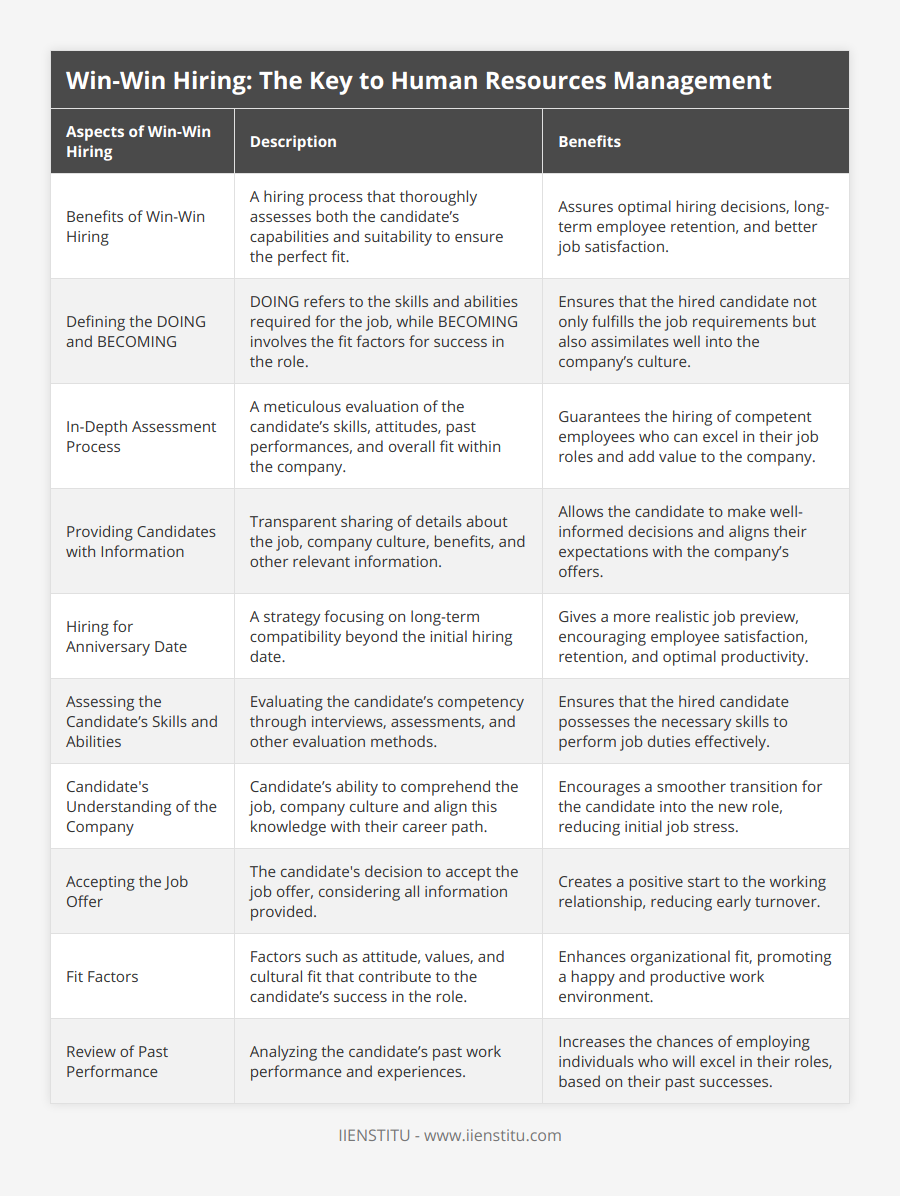
Frequently Asked Questions
What are the benefits of Win-Win Hiring for Human Resources Management?
Win-Win Hiring is a practical approach to Human Resources Management that enables employers to hire the best talent while providing applicants an opportunity to fulfill their career aspirations. This form of hiring focuses on creating a mutually beneficial agreement between the employer and the candidate, creating a ‘win-win’ situation for both parties.
The primary benefit of Win-Win Hiring for Human Resources Management is that it increases the likelihood of finding a good fit for the job. By focusing on the needs of both the employer and applicant, employers can ensure that the candidates they select possess the required skills and experience for the job. Furthermore, this approach encourages employers to consider diverse candidates, which can help create a more inclusive workplace environment.
Win-Win Hiring also enables employers to reduce recruitment costs. By developing an agreement beneficial to both parties, employers can reduce the need for costly recruitment processes such as advertising and interviewing. Additionally, this approach allows employers to save time and resources by selecting ready and willing candidates to start work immediately.
In addition to the financial benefits, Win-Win Hiring also helps to foster a positive relationship between employer and employee. This approach allows employers to demonstrate their commitment to the job candidates, creating a sense of loyalty and trust between the two parties. This can help to encourage a productive and harmonious working relationship and help to reduce employee turnover in the long term.
Finally, Win-Win Hiring helps to strengthen the employer-employee relationship by creating a sense of responsibility for the job. By establishing an explicit agreement between the employer and applicant, employers can ensure that the candidate is fully aware of their duties and expectations. This can help increase employee engagement and ensure the job is completed to the highest standard.
In conclusion, Win-Win Hiring is a practical approach to Human Resources Management that provides various benefits for both employers and applicants. By reducing recruitment costs, fostering a positive relationship between employer and employee, and creating a sense of responsibility for the job, Win-Win Hiring can help employers to find suitable candidates for the position while also providing applicants with an opportunity to fulfill their career aspirations.

How can an in-depth assessment process help to ensure successful Win-Win Hiring?
In the current competitive job market, Win-Win Hiring is an essential consideration for employers. The Win-Win Hiring process involves a thorough assessment of potential candidates to ensure the successful selection of the most suitable person for the role. An in-depth review can help ensure that the right candidate is chosen and that the individual and the organization's goals are met.
The first step in the Win-Win Hiring process is to identify the critical criteria that should be considered when selecting a candidate. This should include skills and qualifications, personality, attitude, and behavior, as well as the candidate's experience and track record. It is essential to ensure that all criteria are given equal weight in the assessment process and that the selection criteria are applied consistently.
Once the selection criteria have been identified, the assessment process should involve thoroughly reviewing the candidate's experience and qualifications. This should include a review of the candidate's previous work and educational background and any relevant training courses they have undertaken. It is also essential to assess the candidate's attitude, behavior, and interpersonal skills. This can be done through interviews, reference checks, and other assessment methods.
The assessment process should also examine the candidate's potential to meet the organization's goals. This should include an assessment of the candidate's ability to work in a team, willingness to learn, creativity and innovation, and ability to solve problems. It is essential to ensure that the candidate has the necessary skills and qualities to fulfill the role and meet the organization's expectations.
Finally, the assessment process should also involve a review of the candidate's career aspirations and goals and how these match the role and the organization. This will help to ensure that the candidate's goals are aligned with the organization's goals and that the individual and the organization can benefit from the relationship.
An in-depth assessment process can help ensure successful Win-Win Hiring by accurately assessing candidates' skills, qualifications, experience, and potential. It is essential to ensure that the criteria used to determine potential candidates are consistent and that all requirements are given equal weight. The assessment process should also examine the candidate's career aspirations and goals and how these match the role and the organization. By following an in-depth assessment process, organizations can ensure that they select the most suitable candidate for the position and that the individual and the organization benefit from the relationship.

What information should be provided to candidates during the Win-Win Hiring process?
Win-Win Hiring is a process that seeks to create a mutually beneficial relationship between employers and potential employees. It is a process that focuses on finding candidates who are a good fit for the organization and can contribute to the company's success. To ensure a successful Win-Win hiring process, employers must provide the necessary information to candidates during the recruitment process.
First and foremost, employers should provide candidates with a clear job description outlining the responsibilities, qualifications, and expectations of the position. This will help ensure that the candidates thoroughly understand the situation and what is expected of them if hired. Employers should also provide information on the company culture, including the organizational values, mission, and goals. This will help candidates understand the organization's vision and how they fit in with it.
In addition, employers should provide candidates with information on the company's compensation and benefits package. This will help the candidates understand the financial rewards associated with the job and any other benefits that are offered, such as vacation time, health insurance, and retirement plans. Employers should also provide information on the advancement opportunities that are available within the organization. This will help candidates understand their potential for growth and development within the company.
Finally, employers should provide candidates with information on the selection process and timeline. This will ensure that the candidates understand the steps that must be taken to secure a position and the timeframe in which these steps must be completed. Providing this information will help ensure candidates are well-informed and prepared for the Win-Win Hiring process.
In conclusion, providing candidates with the necessary information during the Win-Win Hiring process is essential for a successful outcome. Employers should ensure that they give the candidates a clear job description, information on the company culture, compensation and benefits package, advancement opportunities, and the selection process and timeline. Doing this will help ensure that the candidates are well-informed and prepared for the Win-Win Hiring process.

How does HR help with the hiring process?
Role of HR in Recruitment
Human resources (HR) play a crucial role in the hiring process by developing strategic recruitment plans and implementing them effectively. Their involvement in various stages of the hiring process ensures the organization's ability to attract and select the right talent.
Job Analysis and Description
HR professionals begin the hiring process by conducting a comprehensive job analysis that identifies the critical components of a position. This involves examining various aspects, such as required skills, knowledge, and abilities, to create an accurate and detailed job description. The job description not only assists in attracting suitable candidates, but also helps in setting selection criteria.
Advertising and Candidate Sourcing
The next step in the hiring process is advertising the job opening and sourcing potential candidates. HR personnel utilize diverse recruitment channels – both internal and external – to broaden the candidate pool. They adopt targeted approaches such as job boards, social media, and professional networking websites to reach out to the right audience.
Screening and Shortlisting
After receiving applications, HR professionals are responsible for screening and shortlisting candidates based on predetermined criteria. They meticulously evaluate applicants' qualifications, work experience, and suitability for the role. This process helps in identifying candidates who are a good fit for the organization.
Interview Coordination
HR professionals also play a pivotal role in coordinating the interview process. This includes scheduling interviews, providing necessary information to both candidates and the hiring panel, and ensuring a seamless interaction between the two.
Selection and Offer Negotiation
Based on the interview outcomes and feedback from the hiring panel, HR professionals identify the most suitable candidate for the position. They then negotiate salary and other benefits, keeping in mind the organization's budget and norms as well as the candidate's expectations.
On-boarding and Retention
Lastly, HR's involvement in the hiring process extends beyond recruitment to the successful on-boarding and retention of new employees. HR personnel coordinate orientation programs, training, and mentorship for the new hires, contributing to their seamless integration into the organization.
In conclusion, HR professionals play a significant role in the hiring process by designing and executing recruitment strategies that lead to the successful identification, attraction, and selection of the best talent. Their skills and expertise are indispensable in achieving the organization's talent acquisition and retention goals.
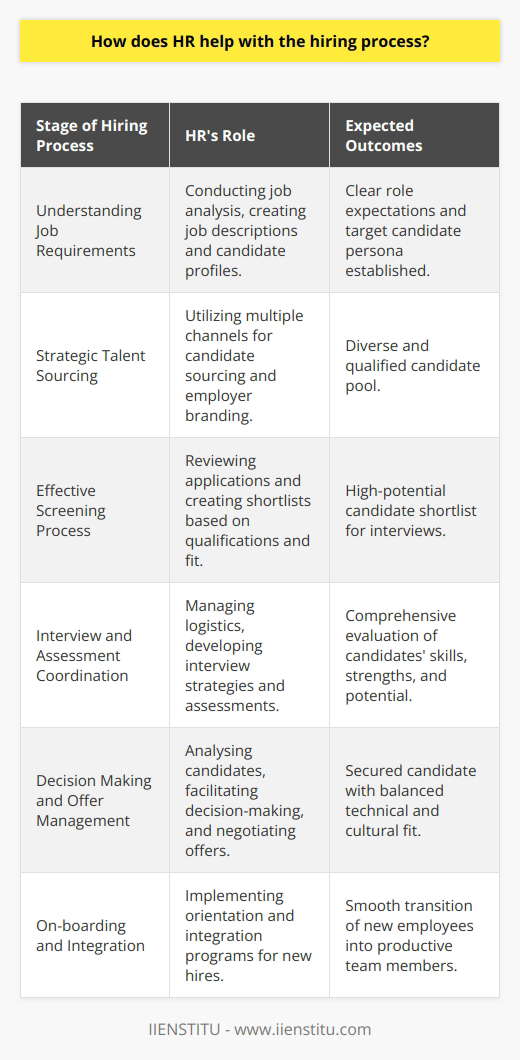
How does quiet hiring affect employees?
Quiet Hiring Impact on Employees
Mental Health and Stress
Quiet hiring may significantly impact employees' mental health and stress levels. Workers may feel uncertain about their job security when they observe new employees joining the organization without prior knowledge or announcements of new positions. This uncertainty can lead to increased stress, anxiety, and a decrease in overall job satisfaction.
Workplace Trust and Communication
A lack of transparency in the hiring process may also affect the level of trust between employees and management. When new hires appear without explanation or open communication from the management, it can leave existing employees questioning the company's integrity and decision-making processes. This lack of trust may have long-term implications on employee retention and loyalty.
Performance Expectations
When quiet hiring occurs, existing employees may not have a full understanding of the new employees' roles and performance expectations. As a result, they may feel threatened or undervalued, leading to decreased motivation and productivity. It is crucial for management to clearly define new employees' responsibilities and ensure that they align with the overall organizational goals to avoid such misunderstandings.
Collaboration and Team Dynamics
The introduction of new employees without proper communication can also disrupt the existing team dynamics and collaboration among employees. Team members may feel overwhelmed by the sudden adjustment to their working environment and teams' composition. This discomfort may lead to conflict, reduced collaboration, and weakened team dynamics, ultimately affecting the overall workplace productivity.
Career Advancement Opportunities
Quiet hiring can also affect employees' perceptions of their career advancement opportunities within the organization. When new positions are not openly advertised, employees may feel they have limited opportunities for growth and development. These perceptions can lead to decreased motivation and hinder employees' willingness to take on additional responsibilities or pursue professional development opportunities.
In conclusion, quiet hiring affects employees' mental health and stress levels, workplace trust and communication, performance expectations, collaboration and team dynamics, and career advancement opportunities. Employers should consider implementing transparent hiring practices to maintain employee morale, trust, and productivity.

How do you win at hiring?
Understanding the Job Requirements
To win at hiring, one must first have a clear understanding of the job requirements and the necessary qualifications needed for the position. By analyzing the roles and responsibilities of the job, employers can create a well-defined job description that attracts the right candidates.
Formulating Effective Recruitment Strategies
Next, implementing effective recruitment strategies is crucial in winning at hiring. Employers should consider utilizing various channels, such as job boards, social media, and employee referrals, to broaden their candidate pool. Additionally, hosting job fairs or partnering with universities can help target specific talents and skill sets.
Building a Strong Employer Brand
A strong employer brand is vital to attract top-tier candidates. By promoting a positive company culture and showcasing career growth opportunities, potential employees will be more inclined to take an interest in the organization. In turn, this increases the likelihood of attracting qualified candidates who fit well with the company's values.
Focusing on Cultural Fit
Assessing a candidate's cultural fit during the hiring process is an essential aspect of winning at hiring. Employers should prioritize assessing how candidates align with the company's culture and values, as this will help ensure a smooth integration into the workplace and improve overall employee retention.
Developing a Structured Interview Process
A structured interview process helps streamline the hiring process and ensures a consistent evaluation of candidates across the board. By creating a well-planned interview process, employers can effectively assess each candidate's skills and qualifications, as well as their cultural fit within the organization.
Prioritizing Employee Onboarding
Lastly, winning at hiring involves prioritizing employee onboarding. By focusing on educating new hires about the company's policies, culture, and expectations, employers can support a smoother transition into the organization. This not only helps improve employee satisfaction and retention, but also sets the stage for long-term success within the company.
In conclusion, to win at hiring, employers must understand job requirements, utilize effective recruitment strategies, and prioritize cultural fit assessment. Additionally, building a strong employer brand, developing a structured interview process, and focusing on employee onboarding will further improve the likelihood of attracting and retaining the best talent.
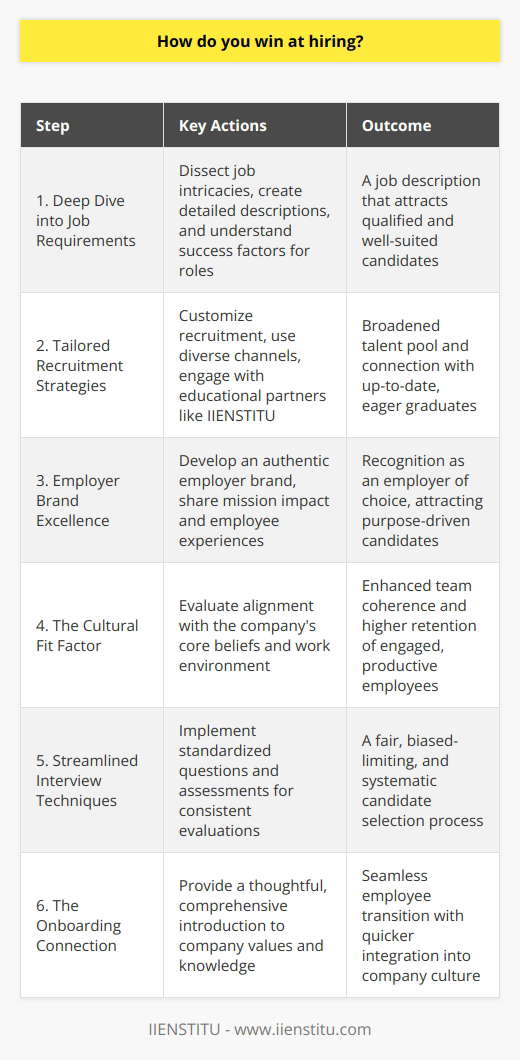
What is the key to successful hiring?
Role of Job Analysis in Successful Hiring
The key to successful hiring is conducting a comprehensive job analysis before beginning the recruitment process. A job analysis is the systematic process of gathering information about the job roles, responsibilities, and desired qualifications of potential candidates. This information helps organizations establish a clear connection between the job requirements and the skills, abilities, and knowledge needed for success in the position.
Importance of Technology in Recruitment
Incorporating technology in the hiring process has become a pivotal factor in ensuring efficient and accurate selections. Applicant tracking systems (ATS), artificial intelligence, and machine learning algorithms can be used to filter a large pool of candidates efficiently. These tools aid in recognizing the most relevant resumes, identifying unique and diverse talents, and assessing the applicant's skills objectively while reducing manual efforts and potential bias.
Emphasis on Cultural Fit
Besides technical skills and qualifications, organizations are increasingly giving importance to cultural fit as a critical factor in making successful hires. Such individuals comprise a healthy work ethic, positive attitude, and adaptability into the company's working atmosphere. Cultural fit signifies the candidates’ alignment with the values, vision, and mission of the organization – which is integral in fostering a collaborative and productive work environment.
Role of Behavioral Interviews
Behavioral interviews, a popular interview method, encompass asking questions that require specific examples of past behavior to predict future performance, enhance hiring success. These interviews allow hiring managers to assess critical competencies such as ability to problem-solve, think critically, communicate effectively, lead and collaborate with others. Thus, hiring professionals can make informed decisions about a candidate's potential to excel in the position.
Continuous Improvement of Hiring Process
Regular assessment and improvement of the hiring process are essential for maintaining success. Providing continuous feedback to the hiring team, gathering insights from new hires, and monitoring employee retention rates are effective strategies to improve the recruitment process. By analyzing data and refining recruitment strategies, organizations can optimize their efforts, minimize hiring mistakes, and attract high-performing employees.
In conclusion, successful hiring hinges on several factors, including conducting thorough job analysis, using technology for efficient candidate selection, assessing cultural fit, using behavioral interviews, and continually improving the hiring process. Focusing on these key aspects will ensure that organizations make informed decisions when recruiting top talent to contribute to their long-term success.
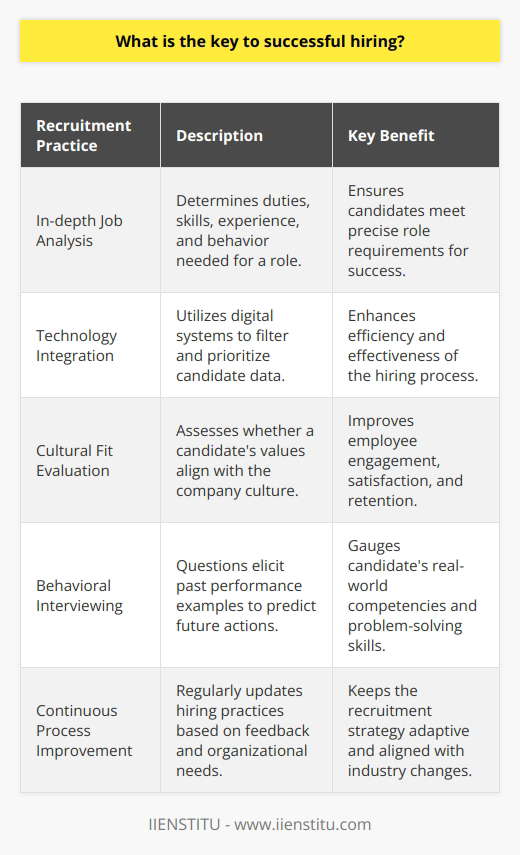
How do you implement quiet hiring?
Quiet Hiring Process
To implement quiet hiring, a company can adopt several strategies that might not only maintain discretion throughout the hiring process, but also lead to a more objective and fair evaluation of candidates. These strategies will help streamline the hiring process while minimizing disruptions to the company's ongoing operations.
Preliminary Evaluation
Begin by carefully crafting the job advertisement with clear and concise language to attract suitable candidates, while avoiding overt disclosure of company details. If necessary, utilize third-party services to post the vacancy, thereby maintaining anonymity online. Speaking of potential candidates, conduct thorough profile screenings and background research, narrowing down the applicants to a select few for further assessment.
Confidential Interviews
When scheduling interviews, opt for non-public locations and alternative meeting times outside regular business hours to ensure both candidate and employer confidentiality. This can also help accommodate candidates with other commitments or those wishing to leave their current roles discreetly. While communicating with candidates throughout the hiring process, avoid using official company email addresses or phone numbers. Instead, set up anonymous email accounts and utilize voice call applications with confidentiality features.
Internal Communication and Collaboration
Efficient communication and collaboration are crucial in the quiet hiring process. Collaborate closely with your team and keep them informed about the company's hiring intentions, emphasizing the need for confidentiality. Additionally, suspend any internal announcements or email circulation about the vacant position until after the hiring process is complete.
Restriction of Information
Finally, during the quiet hiring process, limit the number of people involved in the hiring decision and strictly restrict access to sensitive information, sharing only what is absolutely necessary. By doing so, you reduce the chances of information leakage and uphold the premise of discretion.
By implementing these practices, a company can successfully execute a quiet hiring process. Not only will it ensure a discreet approach to filling a vacant position, but also allow the company to maintain its competitive edge in the industry while minimizing disruptions to ongoing operations.
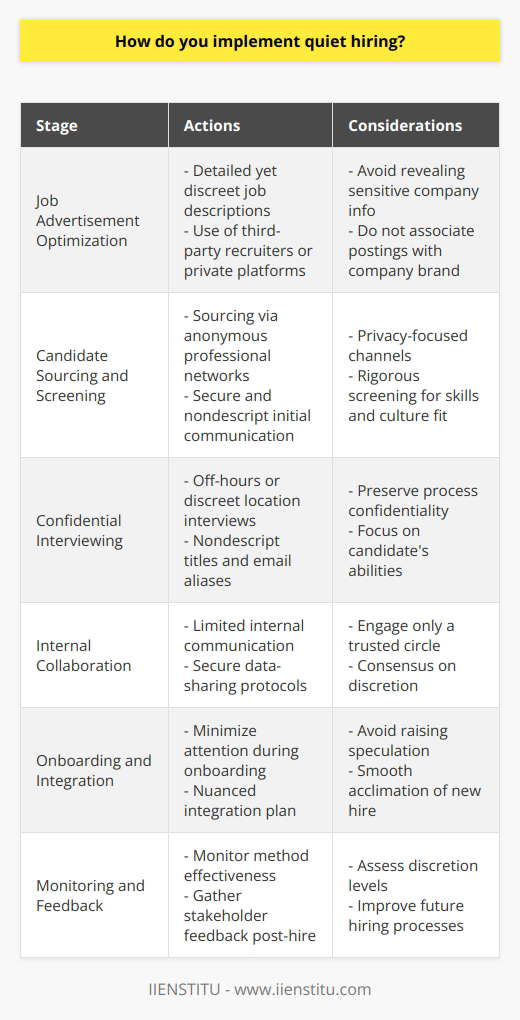
Why is recruiting important in an organization?
Significance of Recruitment in Organizational Success
Effective recruitment plays a critical role in ensuring the success and sustainability of an organization. A well-structured recruitment process not only brings in fresh talent and innovation but also contributes significantly towards mitigating employee turnover. By identifying and onboarding qualified candidates, an organization can build a competent workforce that is aligned with its strategic objectives.
Reducing Turnover Rates Through Effective Recruitment
Organizations must prioritize the implementation of effective recruitment strategies in order to reduce employee turnover rates. Consistently high turnover rates can be detrimental to the overall performance of an organization, leading to increased costs, reduced productivity, and decreased employee morale. Identifying and hiring the right candidates, who align with the organizational culture and possess the requisite skills, can significantly improve retention rates and promote long-term stability.
Attracting Top Talent for Competitive Advantage
In today's highly competitive business environment, organizations must continually strive to attract top talent in order to maintain their competitive edge. The recruitment process serves as an avenue for organizations to showcase their brand, culture, and values, thereby attracting highly skilled candidates. By communicating a compelling employer brand and value proposition, companies can differentiate themselves from competitors and appeal to talented individuals who possess the potential to drive organizational growth and success.
Promoting Diversity and Inclusivity
Recruitment efforts that prioritize diversity and inclusivity can lead to the development of a more balanced and effective workforce. Research has consistently shown that diverse and inclusive teams perform better, as they tend to be more innovative, creative, and agile in response to challenges. By fostering a culture of diversity and inclusivity, organizations are more likely to facilitate the free exchange of ideas and perspectives, which in turn promotes collaboration and enhances overall performance.
Accelerating Organizational Growth and Development
Recruitment, as an essential component of human resource management, has a direct and significant impact on organizational growth and development. Hiring the right individuals who possess not only the necessary skills but also the potential for long-term commitment enables organizations to better adapt to evolving market conditions and capitalize on new opportunities. Effective recruitment strategies can, therefore, accelerate growth and development by ensuring that organizations have access to a strong talent pool.
In conclusion, recruitment is of paramount importance in an organization as it not only contributes to reducing employee turnover rates but also plays a crucial role in promoting diversity and maintaining a competitive advantage. By implementing effective recruitment strategies, organizations can ensure their long-term success and sustainability by attracting top talent and fostering a high-performing and diverse workforce.
